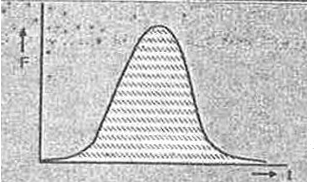A mass moves with a great velocity. It strikes another mass at rest in head-on collision. It comes back along its path with low speed after collision. Then find out whether or .
To solve the problem, we will analyze the situation using the principles of conservation of momentum and the concept of head-on collisions.
1. Understand the Initial Conditions:
- Mass m1 is moving with an initial velocity u.
- Mass m2 is at rest, so its initial velocity is 0.
2. Define Final Velocities:
- After the collision, mass m1 moves back with a lower speed, denoted as u′.
- Let the final velocity of mass m2 after the collision be v.
3. Apply the Conservation of Momentum:
- The total initial momentum before the collision is given by:
Initial Momentum=m1⋅u+m2⋅0=m1⋅u
- The total final momentum after the collision is:
Final Momentum=m1⋅(−u′)+m2⋅v
- According to the conservation of momentum:
m1⋅u=−m1⋅u′+m2⋅v
4. Use the Concept of Head-On Collision:
- For head-on collisions, the principle of velocity of approach and velocity of separation applies:
Velocity of Approach=Velocity of Separation
- This means:
u=v+u′
- Rearranging gives:
v=u−u′
5. Substitute v in the Momentum Equation:
- Substitute v from the previous step into the momentum equation:
m1⋅u=−m1⋅u′+m2⋅(u−u′)
- Expanding this gives:
m1⋅u=−m1⋅u′+m2⋅u−m2⋅u′
6. Rearranging the Equation:
- Rearranging terms leads to:
m1⋅u+m1⋅u′=m2⋅u−m2⋅u′
- This can be factored as:
m1(u+u′)=m2(u−u′)
7. Analyze the Relationship:
- Since u′<u (as given in the problem), we can infer that m1 must be less than m2 for the equation to hold true.
- If m1 were greater than m2, the left side would exceed the right side, contradicting the conditions given.
8. Conclusion:
- Therefore, we conclude that:
m1<m2
- Mass m1 is moving with an initial velocity u.
- Mass m2 is at rest, so its initial velocity is 0.
- After the collision, mass m1 moves back with a lower speed, denoted as u′.
- Let the final velocity of mass m2 after the collision be v.
- The total initial momentum before the collision is given by:
Initial Momentum=m1⋅u+m2⋅0=m1⋅u
- The total final momentum after the collision is:
Final Momentum=m1⋅(−u′)+m2⋅v
- According to the conservation of momentum:
m1⋅u=−m1⋅u′+m2⋅v
- For head-on collisions, the principle of velocity of approach and velocity of separation applies:
Velocity of Approach=Velocity of Separation
- This means:
u=v+u′
- Rearranging gives:
v=u−u′
- Substitute v from the previous step into the momentum equation:
m1⋅u=−m1⋅u′+m2⋅(u−u′)
- Expanding this gives:
m1⋅u=−m1⋅u′+m2⋅u−m2⋅u′
- Rearranging terms leads to:
m1⋅u+m1⋅u′=m2⋅u−m2⋅u′
- This can be factored as:
m1(u+u′)=m2(u−u′)
- Since u′<u (as given in the problem), we can infer that m1 must be less than m2 for the equation to hold true.
- If m1 were greater than m2, the left side would exceed the right side, contradicting the conditions given.
- Therefore, we conclude that:
m1<m2
Topper's Solved these Questions
- BOOK - CENGAGE PHYSICS ENGLISHCHAPTER - CENTRE OF MASSEXERCISE - Subjective23videos
CENTRE OF MASS
- BOOK - CENGAGE PHYSICS ENGLISHCHAPTER - CENTRE OF MASSEXERCISE - Single Correct141videos
CENTRE OF MASS
- BOOK - CENGAGE PHYSICS ENGLISHCHAPTER - CENTRE OF MASSEXERCISE - Exercise 1.223videos
CENTRE OF MASS
- BOOK - CENGAGE PHYSICS ENGLISHCHAPTER - CALORIMETRYEXERCISE - Solved Example13videos
CALORIMETRY
- BOOK - CENGAGE PHYSICS ENGLISHCHAPTER - DIMENSIONS & MEASUREMENTEXERCISE - Integer2videos
DIMENSIONS & MEASUREMENT
Similar Questions
A ball of mass m1 is moving with velocity 3v. It collides head on elastically with a stationary ball of mass m2 . The velocity of both the balls become v after collision. Then the value of the ratio m2m1 is
View SolutionA body of mass 'm' moving with certain velocity collides with another identical body at rest. If the collision is perfectly elastic and after the collision both the bodies moves
View SolutionA body of mass m1 moving with uniform velocity of 40 m/s collides with another mass m2 at rest and then the two together begin to moe wit h uniform velocity of 30 m/s. the ratio of their masses m1m2 is
View SolutionA body of mass m1 moving with uniform velocity of 40 m/s collides with another mass m2 at rest and then the two together begin to moe wit h uniform velocity of 30 m/s. the ratio of their masses m1m2 is
View SolutionA heavy vehicle moving with velocity 15 m/s strikes an object of very small mass at rest head on elastically. Velocity of object ater collision is
View SolutionBody A of mass 4m moving with speed u collides with another body B of mass 2m at rest the collision is head on and elastic in nature. After the collision the fraction of energy lost by colliding body A is :
View SolutionA block of mass m moving at speed υ collides with another block of mass 2 m at rest. The lighter block comes to rest after the collision. Find the coefficient of restitution.
View SolutionA sphere of mass m1 in motion hits directly another sphere of mass m2 at rest and sticks to it, the total kinetic energy after collision is 2/3 of their total K.E. before collision. Find the ratio of m1:m2.
View SolutionAn object of mass m1 moving with speed v collides with another object of mass m2 at rest and stick to it. Find the impulse imparted to the second object.
View SolutionThe area of F.t curve is A. If one of the colliding bodies of mass m is at rest, find its speed just after the collision.
 View Solution
View Solution

